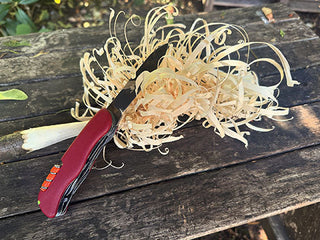Practise, practise, practise. This is the golden truth to developing knowledge and skills in just about anything, but it applies particularly to learning bushcraft. We apply our understanding of the natural world to survive and thrive in that environment, and it takes time and dedication to build up our skills. The problem, of course, is that we often don’t have time: I have a full-time desk job, like a lot of people, and my children have their own hobbies and interests that I seem to be the eternally suffering taxi-driver for. What hope is there of practising my bushcraft when I can’t get time in the woods? After some trial and error, here are five quick tips on making the most of those quiet moments.
1) Keep a small hank of cordage on you. This can be paracord, or perhaps you have made some natural cordage. Keep some in your rucksack, in your glovebox. There are lots of bushcraft skills that are not easy to learn online, but knots are one of the skills that YouTube is great for. While you are waiting for a train, or on a lunch break, or waiting to pick your kids up from netball, learn a new knot. Use your coffee cup as the ‘tree’, and tie your Evenk Hitch. Run a Bowline around your gearstick. Slip a Taught Tarp Hitch around that lamppost. Knots are about muscle memory: if you practise them, they will become second nature to you.
 bushcraft
bushcraft
2) Carry a UK legal folding knife. These are knives that have a cutting edge of no longer than 3 inches, and fold without a lock. Sharpen your kids' school pencils, feather a stick, carve a simple tent peg. This is about getting used to crafting wood with your knife, and the various grips that we employ - like any with other tool, regular use will make you more proficient.

3) Identify the trees and plants you encounter on your usual walks - perhaps in your local park or on your lunchtime stroll. Start a notebook, and buy a guide to the UK's tree and plant species. Try not to be tempted by the (very impressive) ID apps on your phone, because this is less about finding an 'answer', and instead becoming more aware of what is around you, and how to read what you see. Look to the shape of the leaves, the texture of the bark, the outline of the tree. You will quickly fall into a hidden world, and it can feel a little overwhelming. Take it one step at a time, and go at your own pace. There are too many trees and plants to know in a lifetime of study, so start with the ones around you: how do you identify them, and what are they good for?

4) Use a compass to find new routes to work, or to the gym, or the shops, or anywhere. Buy a map of your local area, and try to use your compass to find your way rather than Google Maps. I usually challenge myself to find a coffee shop, as the promise of caffeine is a strong motivator!

5) Teach your family what you have learned. Richard Feynman once said that 'the best way to learn something is to teach it'. Rope in your parents, siblings, or children, and show them how to do something you have learned. Make sure it is safe for them, of course, and give them space, time and encouragement to learn. I often practise bushcraft with my kids - here's my 8-year old son during one of our regular 'coffee and carving' sessions in the woods (he has blackcurrant squash...)


